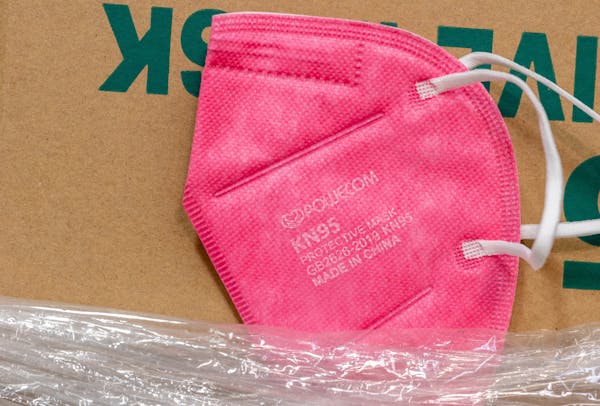As the highly contagious omicron variant causes record COVID-19 cases across the U.S., people are swapping in N95 masks for their old cloth face coverings to better ward off the virus.
N95 respirators are proven to provide high levels of protection against the droplets that cause infections leading to COVID-19 — and many doctors and public health experts are now advocating for their use among the general population.
"We strongly support people wearing more effective facepieces, including respirators," wrote researchers at the University of Minnesota's Center for Infectious Disease Research and Policy.
Early in the pandemic, the general public was discouraged from buying these masks over fear there wouldn't be enough for health care workers. That's no longer the case.
The center's director, Michael Osterholm, said Tuesday there is "more than adequate stock for health care workers as well as the general public."
N95 masks are much easier to find now than in early 2020 after manufacturers, like Maplewood-based 3M, ramped up production.
"You can get them at all the different retail outlets, home improvement stores, online in places you'd expect," said Raymond Eby, president of 3M's personal safety division. "The demand is increasing tremendously, but as of right now we're able to supply those outlets."
Robust respirator production is likely needed. The Centers for Disease Control and Prevention is poised to recommend daily N95 and KN95 use for those who can tolerate it, according to the Washington Post.
3M is the largest producer of N95s in the United States and went to around-the-clock production nearly two years ago, eventually tripling production capabilities over 2019 levels.
In 2020 the company reached its goal of producing 2 billion N95s and made 2.5 billion in 2021.
"Sometimes it goes on a month-to-month basis," Eby said about current production levels. "Who knows if this is going to last for a year? So that's been the tricky part."
On Wednesday, Eby will visit a Nebraska plant that produces N95s to thank the workers for "being able to do this for people worried about their loved ones," he said. "I hope we get back to a state of normalcy, but if it's needed, we'll be here."
Why an N95?
Masks are best at keeping your exhaled particles away from others. Respirators, like the N95, also keep others' particles away from you.
3M was the first to make disposable filtering face masks approved by the National Institute for Occupational Safety and Health (NIOSH), a federal agency, in the 1970s. Originally designed for industrial use, 3M's N95 masks were improved over time for use in other settings like health care.
N95 is not a brand name but a NIOSH certification of effectiveness — blocking at least 95% of airborne particles. So while 3M N95 respirators are the market leaders, other brands and designs carry the certification.
Experts have recommended respirators since the beginning of the pandemic, and now "even more so with this high level of contagion," Eby said.
How does it work?
Two things give the N95 its high level of effectiveness: the filter and the fit.
Inside the mask is an electrostatic filter that prevents particles — including viruses, bacteria and dust — from getting through.
A properly fitted mask ensures all air is passing through that filter and not leaking around the edges, which would allow particles in and out.
How do I wear it?
Eby said a number of online resources and videos can help users properly wear respirators. One strap should be below the ears and the other on the crown of the head. The metal nose clip should be formed with two hands. Those with facial hair can't get a complete seal, 3M says.
3M's basic fit-test to check for a good seal goes like this:
"Place both hands completely over the respirator and inhale sharply. A negative pressure should be felt inside the respirator. If air leaks around nose, readjust the nose piece. If air leaks at the respirator edges, work the straps back along the sides of your head. If you cannot get a secure seal, look for another respirator model that fits you correctly."
Can I reuse it?
For daily life outside of hospitals, an N95 can be re-used so long as it doesn't get dirty or wet and maintains a proper seal.
Eby said wearers should cycle through multiple respirators throughout the week. Used masks can be placed in a paper bag for at least 72 hours.
What's with the different shapes and designs?
Any bona fide N95 has been certified to filter at least 95% of particles.
N95s with valves were produced for industrial settings that focused on keeping dust from getting in the mask rather than stopping pathogens from getting out, Eby said.
As such, N95 masks without a valve are seen as the best choice in a pandemic.
"We're selling a lot more without a vent for that reason," he said.
What is a KN95?
An N95 is certified by the U.S. government to be as effective as advertised. A KN95 is certified by Chinese government standards to filter 95% of particles.
The CDC warns that "about 60% of the KN95 respirators in the United States are counterfeit" and don't meet U.S. safety guidelines.
How to spot a counterfeit?
Counterfeit N95 and KN95 sales flourished while respirators were in short supply and largely diverted to health care workers in 2020.
The risks are lower when buying from mainstream retail outlets, but the CDC says to watch for a lack of markings on the respirator or headband and the use of ear loops instead of dual headbands.
Here's more from The New York Times on how to choose a quality mask and how to avoid counterfeits.
First major attempts to regulate AI face headwinds from all sides

